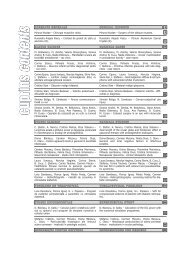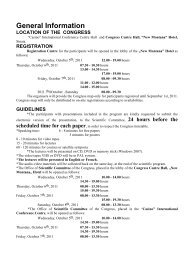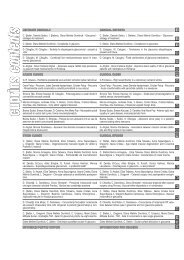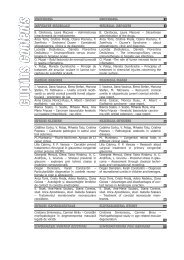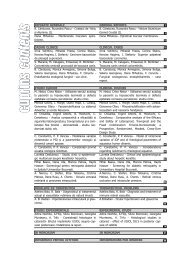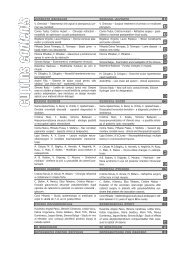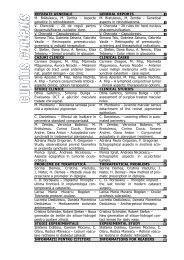Interior 2_2006.qxd - Oftalmologia.ro
Interior 2_2006.qxd - Oftalmologia.ro
Interior 2_2006.qxd - Oftalmologia.ro
Create successful ePaper yourself
Turn your PDF publications into a flip-book with our unique Google optimized e-Paper software.
INTRODUCTION<br />
The lens represents a very complex structure<br />
consisting of water, carbohydrates, lipids, p<strong>ro</strong>teins<br />
and oligoelements. The current studies show that the<br />
biochemical mechanisms in age related cataract are<br />
not entirely understood.<br />
METHOD<br />
In our study 72 lenses were taken for biochemical<br />
examinations.<br />
The study included 3 g<strong>ro</strong>ups of lenses. The first<br />
g<strong>ro</strong>up (31 lenses) consisted of mature age related<br />
cataracts, the second g<strong>ro</strong>up (31 lenses) with incipient<br />
age related cataracts and the third g<strong>ro</strong>up (10 lenses)<br />
with normal lenses. The normal lenses were take<br />
f<strong>ro</strong>m clear enucleated eyes with cho<strong>ro</strong>idal melanoma.<br />
Opaque lenses with initial and mature cataract were<br />
obtained by extracapsular extraction and phacoemulsification<br />
techniques. The visual acuity of patients<br />
with initial cataract was between ½ and 1/6; the<br />
visual acuity for patients with mature cataract was<br />
lower than 1/6. The mean age of the patients was 60<br />
years and their serum biochemical p<strong>ro</strong>file was in the<br />
normal limits. The selected patients were chosen for<br />
"healthy" reasons, without diabetes mellitus or other<br />
serious diseases. Some of them had arterial hypertension<br />
under suitable treatment.<br />
Each lens has been put separately on a strip of<br />
celluloid which was kept on ice. After that, the lenses<br />
were weighed at laboratory balance and then mixed<br />
into a glass bottle with a balanced solution of PO4<br />
M/15 until at + 4 0<br />
C until homogeneous samples were<br />
obtained. The balance solution performed a mixture<br />
lens dilution about 50 mg of lens tissue/ml. The samples<br />
were centrifuged to centrifuge cups of a refrigerated<br />
centrifuge at 4000 rpm for 10 minutes. The<br />
supernatant was decantated f<strong>ro</strong>m the sediment. Each<br />
supernatant was refrigerated until examinations.<br />
RESULTS AND DISCUSSIONS<br />
Our results were reported to 100 g of lens tissue.<br />
The examinations were performed at a Randox<br />
Daytona automated chemistry analyzer.<br />
GLUCOSE<br />
OFTALMOLOGIA 2 - 2006<br />
Principle of reaction:glucose is determined after<br />
enzymatic oxidation in the presence of glucose oxidase;<br />
the hyd<strong>ro</strong>gen pe<strong>ro</strong>xide p<strong>ro</strong>duced reacts catalysed<br />
by pe<strong>ro</strong>xidase, with phenol and 4 aminophenazone<br />
to form a red-violet quinoneimine dye as indicator;<br />
the intensity of the final color is directly p<strong>ro</strong>portional<br />
to the glucose concentration and is measured<br />
at 505 nm.<br />
Lens carbohydrate metabolism represents a very<br />
active area of research. Current studies show that:<br />
about 3 % of lens glucose is metabolized by ae<strong>ro</strong>bic<br />
pathway, about 5 % is metabolized by pentose phosphate<br />
pathway, about 3-5 % is metabolized by sorbitol<br />
pathway and the more active pathway is anae<strong>ro</strong>bic<br />
glycolysis.<br />
Our study notices that the level of glucose in the<br />
incipient cataract is much higher than in the normal<br />
lens. In the mature cataract the level of glucose is<br />
higher than in the normal lens. What does it means?<br />
It means that in cataract, the glucose with water<br />
(which are p<strong>ro</strong>vided by the aqueous humor) pass free<br />
th<strong>ro</strong>ugh the alterate membranes into the lens nucleus<br />
and the glycolysis mechanism is not functional,<br />
because the lens tissues are altered. The mature<br />
cataract has too little biochemical elements but anyhow<br />
it has more glucose than the normal lens. We<br />
have found that in "normal conditions" with normal<br />
serum glucose, the age related opaque lens glucose<br />
lever is very high just like the levels of lens glucose<br />
f<strong>ro</strong>m diabetes mellitus.<br />
45




